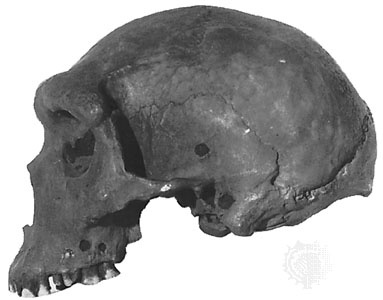Homo heidelbergensis
hominin
 extinct species of archaic human (genus Homo) known from fossils dating from 600,000 to 300,000 years ago in Africa, Europe, and possibly Asia. The name first appeared in print in 1908 to accommodate an ancient human jaw discovered in 1907 near the town of Mauer, 16 km (10 miles) southeast of Heidelberg, Germany. Among the fossils found with the Heidelberg jaw were those of several extinct mammals that lived about 500,000 years ago.
extinct species of archaic human (genus Homo) known from fossils dating from 600,000 to 300,000 years ago in Africa, Europe, and possibly Asia. The name first appeared in print in 1908 to accommodate an ancient human jaw discovered in 1907 near the town of Mauer, 16 km (10 miles) southeast of Heidelberg, Germany. Among the fossils found with the Heidelberg jaw were those of several extinct mammals that lived about 500,000 years ago. The Heidelberg jaw, also called the Mauer jaw, lacks a chin and is exceptionally thick and broad. The teeth are surprisingly small for such a massive mandible. The jaw is also long, and this feature may imply that the individual had a projecting lower face. Among other examples of H. heidelbergensis, the best are specimens from Bodo (Ethiopia), Kabwe (Kabwe cranium) (Zambia), Ndutu (Tanzania), Petralona (Petralona skull) (Greece), Arago (France), and possibly Dali (China). The craniums have massive browridges, long and low braincases, and thick vault bones like H. erectus (Homo erectus). Their braincases are larger than what is typical for H. erectus, but the skulls lack the unique specializations that characterize the Neanderthals. The expanded brain necessitates the modern features seen in the skull, such as the more-rounded rear of the skull (occipital), expanded sides (parietals), and broadened forehead.
The Heidelberg jaw, also called the Mauer jaw, lacks a chin and is exceptionally thick and broad. The teeth are surprisingly small for such a massive mandible. The jaw is also long, and this feature may imply that the individual had a projecting lower face. Among other examples of H. heidelbergensis, the best are specimens from Bodo (Ethiopia), Kabwe (Kabwe cranium) (Zambia), Ndutu (Tanzania), Petralona (Petralona skull) (Greece), Arago (France), and possibly Dali (China). The craniums have massive browridges, long and low braincases, and thick vault bones like H. erectus (Homo erectus). Their braincases are larger than what is typical for H. erectus, but the skulls lack the unique specializations that characterize the Neanderthals. The expanded brain necessitates the modern features seen in the skull, such as the more-rounded rear of the skull (occipital), expanded sides (parietals), and broadened forehead.Until the 1990s it was common to place these specimens either in H. erectus or into a broad category along with Neanderthals that was often called archaic H. sapiens (Homo sapiens). A problem with the latter designation was the growing recognition that Neanderthals (Neanderthal) were unique to and relatively isolated in Europe and western Asia. It therefore became common to categorize the Neanderthals as a separate and morphologically well-defined species, H. neanderthalensis. At the same time, lumping specimens such as those found at Bodo and Petralona with modern H. sapiens would have created an unreasonably heterogeneous species, since modern H. sapiens is remarkably homogeneous in morphology and behaviour and differs strongly from archaic Homo species. Designating the Bodo and Petralona specimens as H. heidelbergensis emphasizes the uniqueness of modern H. sapiens (Homo sapiens), Neanderthals, and H. erectus. Using this taxonomy, it appears to many researchers that H. heidelbergensis is the common ancestor of both Neanderthals and modern man, with the transition from H. heidelbergensis to H. sapiens having occurred in Africa between 300,000 and 200,000 years ago.
- Braun, Wernher von
- Brautigan, Richard
- Bravais, Auguste
- Brava Island
- Bravais lattice
- Bravo, Nicolás
- Braxton, Anthony
- Braxton Bragg
- Bray
- Bray, Thomas
- Brazdžionis, Bernardas
- Brazil
- Santa Ana
- Santa Ana Mountains
- Santa Ana Volcano
- Santa Anna, Antonio López de
- Santa Barbara
- Santa Bárbara
- Santa Catalina Island
- Santa Catarina
- Santa Clara
- Santa-Clara
- Santa Clara University
- Santa Clarita
- Santa Claus